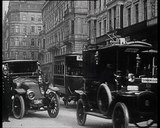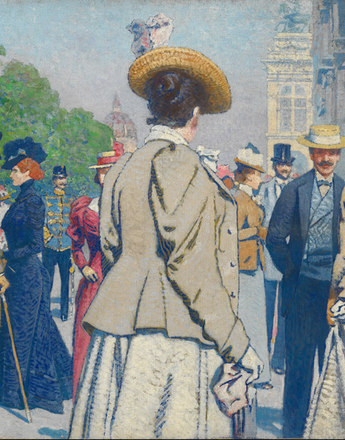Mobility in film: conquering new spaces
Railways and steamships offered people greater mobility in the nineteenth century, boosted around 1900 by bicycles, automobiles and aeroplanes and also shown in films. Mobility became a visual experience.
The experience of individual mobility was accessible to the general public through the velocipede. It gave a sense of freedom, permitting people to quit the everyday world and discover the surrounding area. For women, the bicycle was a form of emancipation, despite the dire warnings by some of the moral degeneracy that these vehicles were supposed to represent. At the turn of the century there were between 300,000 and 400,000 bicycles in the Monarchy, and in Austria-Hungary some 60,000 were manufactured annually in 25 factories.
The invention and use of electric motors enlarged transport possibilities. The most important means of transport for persons and goods was the railway. Its important was emphasized in the Austrian half of the Danube Monarchy through the establishment of a dedicated ministry in 1896. Steam-driven locomotives meant that even remote regions were made accessible. The development of the railway network in mountainous areas in particular was a remarkable feat of engineering. As the main railway lines was gradually nationalized, the rail network had grown by 1913 to 46,000 km. The crossing of mountainous terrain gave a great boost to tourism. Affluent citizens could be transported to the spas in Gastein and Karlsbad [Karlovy Vary], the pilgrimage centre Mariazell, the Salzkammergut, Semmering and Arlberg. The first electrified section between Mödling and Hinterbrühl opened in October 1883, and the network was further extended up until the outbreak of the First World War. The opening of new electrified sections was always an occasion for a special ceremony. Camera teams immortalized these historic technical moments, such as the opening of the new Vienna – Pressburg [Bratislava] line (Opening of the Vienna-Pressburg Electric Railway, A/F 1914).
Tram lines were also electrified. The first attempts to operate an electric tramway in Vienna were undertaken around 1880. In 1883 Siemens & Halske operated an electric tram in the Prater between Schwimmschulallee (Lassallestrasse) and the Rotunde (length 1.5 km). In May 1896 the Wiener Tramway-Gesellschaft carried out its first trials with electric trams. When the power utility was taken over by the city in 1897, the trams were also electrified, and the appearance of the city changed accordingly. Pictures of the increasingly dense traffic on Opernring in 1908 show not only horse-drawn trams and carriages but also electric trams and automobiles (Vienna c. 1908, A/F 1908).
Translation: Nick Somers
Czeike, Felix: Historisches Lexikon Wien, Band 5, Wien 1997
Leidinger, Hannes/Moritz, Verena/Moser, Karin: Österreich Box 1: 1896–1918. Das Ende der Donaumonarchie, Wien 2010
Sandgruber, Roman: Ökonomie und Politik. Österreichische Wirtschaftsgeschichte vom Mittelalter bis zur Gegenwart, Wien 1995
-
Chapters
- Cinematic fascination: the machine in war propaganda
- Mobility in film: conquering new spaces
- The thrill of speed in film: heroes of the road and air
- Voyaging and travelling: tourism and tourism films
- Capturing the unusual: the Vienna Prater
- Movement in films – sport, gymnastics and physical culture
- Power and the public: political movements in historical films





